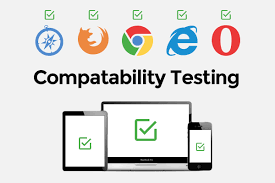Introduction
First, let’s have a web testing checklist:-
- Functionality Testing
- Usability testing Computer; tablet and smart phone functionality
- Interface testing
- Compatibility testing W3C, Markup Validation
- Performance testing
- Security testing

1. Functionality Testing
Test for:
all the links in web pages;
database connection;
forms used in the web pages for
submitting or getting information from user;
cookie testing.
Check all the Links
Test the outgoing links from all the pages from specific domain under test
Test all internal links
Test links jumping on the same pages
Test links used to send the email to admin or other users from web pages
Test to check if there are any orphan pages
Lastly in link checking, check for broken links in all above-mentioned links
Test Forms in all Pages
Forms are the integral part of any web site. Forms are used to get information
from users and to keep interaction with them. So what should be checked on these forms? First check all the validations on each field Check for the default values of
fields Wrong inputs to the fields in the forms Options to create forms if any, form
delete, view or modify the forms.
Cookies Testing
Cookies are small files stored on the user machine. These are basically used to maintain the session mainly login sessions. Test the application by enabling or disabling the cookies in your browser options. Test if the cookies are encrypted before writing to user machine. If you are testing the session cookies (i.e., cookies expire after the sessions ends), check for login sessions and user stats after session end. Check effect on application security by deleting the cookies. (I will soon write a separate article on cookie testing.)
Validate Your HTML/CSS
If you are optimizing your site for Search engines, then HTML/CSS validation is very important. Mainly validate the site for HTML syntax errors. Check if site is crawlable to different search engines.
Database Testing
Data consistency is very important in web application. Check for data integrity and errors while you edit, delete, modify the forms or do any DB related functionality. Check if all the database queries are executing correctly, data is retrieved correctly and also updated correctly. More on database testing could be load on DB, we will address this in web load or performance testing below.
2. Usability Testing
 Usability Testing means the Web site should be easy to use. Instructions should be provided and tool tips used where possible.
Usability Testing means the Web site should be easy to use. Instructions should be provided and tool tips used where possible.
Test for Navigation.
Navigation means how the user surfs the web pages, uses different controls like buttons, boxes or how user uses the links on the pages to surf to different pages.
Main menu should be provided on each page. It should be consistent.
Content Checking
Content should be logical and easy to understand. Check for spelling errors.
Use of dark colors annoys users and should not be used in site theme. You can follow some standards that are used for web page and content building. These are common accepted standards like I mentioned above about annoying colors, fonts, frames, etc. Content should be meaningful.
All the anchor text links should be working properly. Images should be placed properly with proper sizes. These are some basic standards that should be followed in web development. Your task is to validate all for UI testing.
Other user information for user help: Like search option, sitemap, help files, etc., sitemap should be present with all the links in web sites with proper tree view of navigation. Check for all links on the sitemap. “Search in the site” option will help users to find content pages they they are looking for easily and quickly. These are all optional items and if present, should be validated.
3. Interface Testing
 The main interfaces are:
The main interfaces are:
Web server and application server interface Application server and database server interface Check if all the interactions between these servers are executed properly. Errors are handled properly. If database or web server returns any error message for any query by application server, then application server should catch and display these error messages appropriately to users.
4. Compatibility Testing

- Browser compatibility
- Operating system compatibility
- Mobile browsing
- Screen resolution and aspect ratio
- Printing options
Your web site coding should be cross browser platform compatible. If you are using JavaScripts or AJAX calls for UI functionality, performing security checks or validations, then give more stress on browser compatibility testing of your web application.
Browser compatibility
Test web application on different browsers like Internet Explorer, Firefox, Netscape Navigator, AOL, Safari, Opera browsers with different versions.OS compatibility
Some functionality in your web application may not be compatible with all operating systems. All new technologies used in web development like graphics designs, interface calls like different APIs may not be available in all Operating Systems. Test your web application on different operating systems like Windows, Unix, MAC, Linux, Solaris with different OS flavors.Mobile browsing
This is the new technology age. So in future, Mobile browsing will rock. Test your web pages on mobile browsers. Compatibility issues may be there on mobile.Screen resolution and aspect ratio
Typical screen resolutions: 720p, 1080p, 1440p, 4K and 8K.Aspect ratios: 4:3 ; 16:9 and 16:10 for example.
How do these asfect your web site performance.
Printing options
If you are giving page-printing options, then make sure fonts, page alignment, page graphics are getting printed properly. Pages should fit to paper size or as per the size mentioned in the printing option.5. Performance Testing
 Web performance testing should include:
Web performance testing should include:
Web Load Testing
Web Stress Testing
Test application performance on different internet connection speeds. In web load testing, test if many users are accessing or requesting the same page. Can system sustain performance in peak load times?
Site should handle many simultaneous user requests, large input data from users, simultaneous connection to DB, heavy load on specific pages etc.
Stress testing:
Generally stress means stretching the system beyond its specification limits. Web stress testing is performed to break the site by giving stress and checked how system reacts to stress and how system recovers from crashes. Stress is generally given on input fields, login and sign up areas. In web performance testing web site functionality on different operating systems, different hardware platforms are checked for software, hardware memory leakage errors,
6. Security Testing
 Following are some test cases for web security testing:
Test by pasting internal URL directly into browser address bar without login. Internal pages should not open.
If you are logged in using username and password and browsing internal pages, then try changing URL
options directly, i.e., If you are checking some publisher site statistics with publisher site ID=123.
Try directly changing the URL site ID parameter to different site ID which is not related to logged in user.
Access should be denied for this user to view others stats.
Try some invalid inputs in input fields like login username, password, input text boxes. Check the system
reaction on all invalid inputs.
Following are some test cases for web security testing:
Test by pasting internal URL directly into browser address bar without login. Internal pages should not open.
If you are logged in using username and password and browsing internal pages, then try changing URL
options directly, i.e., If you are checking some publisher site statistics with publisher site ID=123.
Try directly changing the URL site ID parameter to different site ID which is not related to logged in user.
Access should be denied for this user to view others stats.
Try some invalid inputs in input fields like login username, password, input text boxes. Check the system
reaction on all invalid inputs.
Web directories or files should not be accessible directly unless given download option. Test the CAPTCHA for automates scripts logins. Test if SSL is used for security measures. If used, proper message should get displayed when user switches from non-secure http:// pages to secure https:// pages and vice versa.
All transactions, error messages, security breach attempts should get logged in log files somewhere on web server.
Conclusion
This is a brief over view of website testing methods. Detailed test plans are used for specific sites, and tailored to the sites functionality. Clearly website testing is an important part of publishing and maintaining websites, for users to enjoy their experience when visiting sites.
David Parker Mobile: 07450 033546 January 2017
